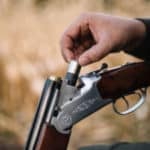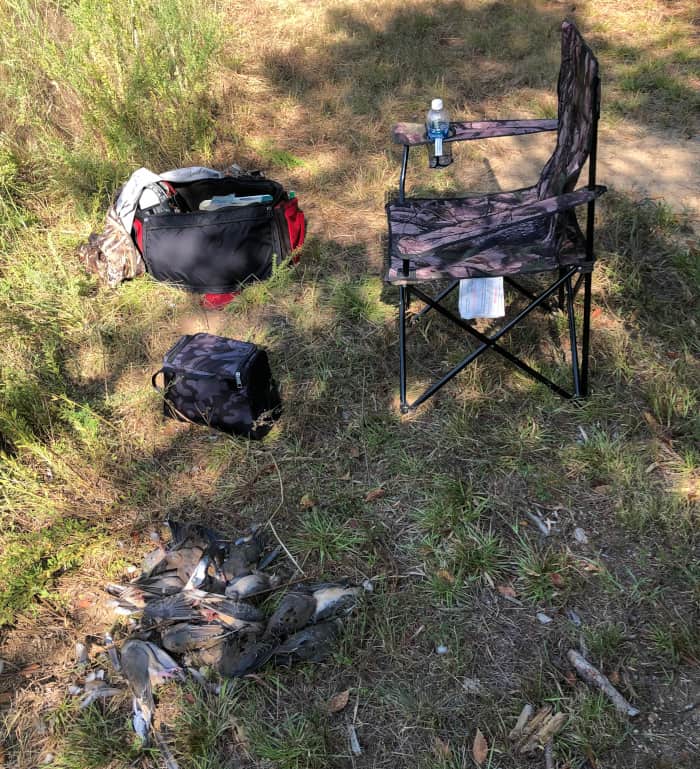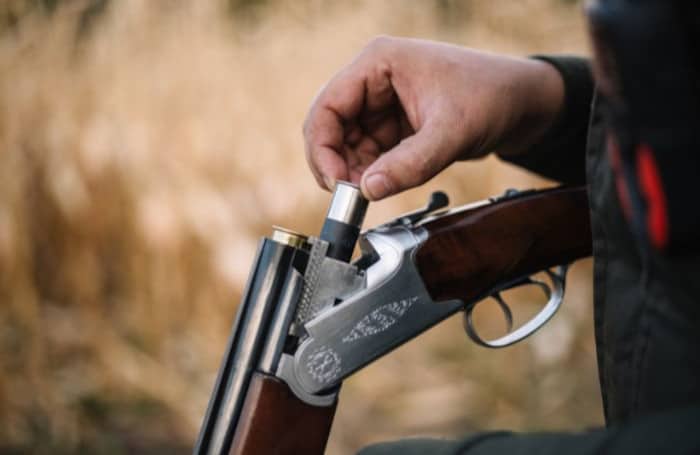As summer winds down and September approaches, wing shooters all across the country begin to prepare for dove season. Shells will be purchased, plans will be made, coolers will be packed, and thousands of hunters will fire an untold number of shotgun shells at twisting and turning dove species in dove fields across the country. One commonly asked question before every dove season is this: what’s the best choke for dove hunting?
Truth be told, it’s not a simple black and white answer because dove hunting conditions change as the season progresses. The shotgun choke that was ideal at the start of the season may not be your best choice for late-season doves.
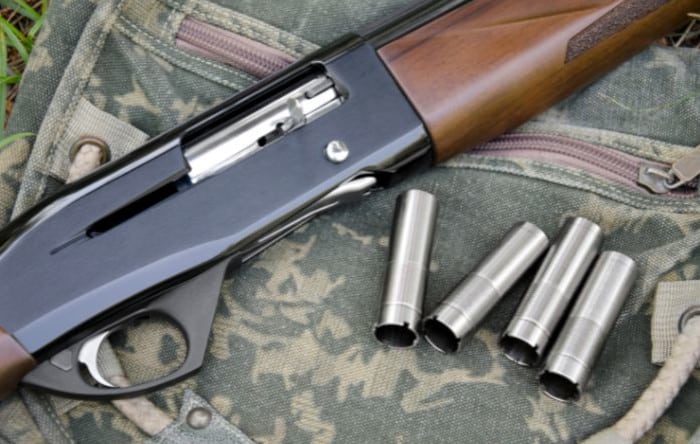
Before I get into details about the ideal choke for hunting doves, let me cover a few basics about shotguns and dove season.
Introduction to Dove Hunting Season
Doves are one of the most popular game bird species, with an estimated 20 million harvested annually during their regulated hunting season. Dove season traditional opens each year around the beginning of September. In most states, the first Saturday of September is the first day of dove hunting season, and it generally also happens to occur over the Labor Day weekend.
The opening day of the season varies from state to state, as do hunting regulations and bag limits. Some states have a single season, while others may have a season broken down into more than one segment. For example, in my home state of North Carolina, dove season starts on the first Saturday of September and is broken down into three periods from open day until January 31st.
Most states also have rules requiring the dove to be in flight to be eligible for harvesting (so you can’t shoot doves out of trees or on the ground). Doves are strong fliers with a top air speed of 55 to 60 miles per hour.
Doves are a fast-moving and tricky target for a hunter as they are capable of quick bursts of speed combined with abrupt changes of direction. It’s estimated that the average hunter shoots on a 5 to 1 ratio, meaning that it takes the average hunter five shots to bring down one bird. However, I can honestly say that I’ve had days in the dove field where I shot much better than the 5-to-1 ratio and other days where I didn’t even come close to hitting one bird with every five shots.
Doves (especially Mourning Doves) are not overly durable or difficult to bring down as a game bird species. Only a few shotgun pellets in the right place are more than enough to bag most of these challenging game birds.
Overview of Shotgun Chokes
The shotgun choke topic is one that most bird hunters are familiar with, but not all understand how it works. Likewise, many hunters are aware of suggested chokes for specific game species, but most don’t know precisely how a particular choke performs in relation to shotgun gauge and shotshell. Typically, hunters will hit more birds if they have a clear understanding of the relationship between shotgun chokes and shot sizes.
What is a Shotgun Choke?
When a shotgun is fired, the pellets in the shell leave the barrel and begin to spread in a funnel-shaped pattern. A shotgun choke is a constriction at the muzzle end of the shotgun barrel that determines the pattern of the shotgun pellets as they are fired and move downrange or out towards the target.
The tighter the choke, the tighter the shotgun pellet pattern. The more open the choke, the more open the pellet pattern as it travels downrange.
The level or choke, combined with the specific shotgun shotshell number, determines the coverage of the shotgun pellets as they move away from the shotgun muzzle. This coverage plays a role in determining the effective range and coverage of the pellets moving towards the target.
It may sound unclear but keep reading as it should start to make sense.
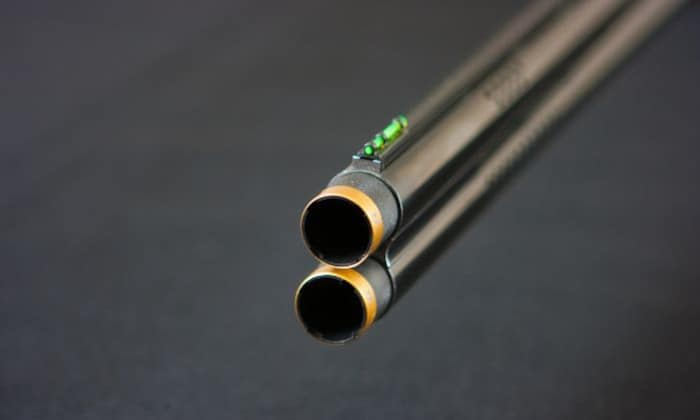
Choke Types
The shotgun industry uses a uniform set of chokes and choke names to help hunters and shooters determine the best choice for specific uses. Those choke types typically fall into one of two categories:
- Common chokes
- Specialty chokes
Let’s go into more detail on each of those categories:
Common Chokes
Common chokes are the shotgun chokes that are most commonly seen in the shotgun industry, and those chokes include the following:
Full Choke
A full choke is the tightest of all the common chokes, producing a dense pattern with a narrow spread of pellets and offering the most power at longer distances. The full choke is best used for waterfowl, small game at longer distances, and turkey hunting.
Improved Modified
The improved modified choke features less muzzle constriction compared to a full choke, so the shot string of pellets stays together. As a result, it’s a good choice for shotgunning situations like short-range waterfowl with steel shot or pheasant hunting with shots at longer distances. The typical effective range for improved modified is 40 to 45 yards (depending on the shotgun gauge and shotshell selection).
Modified
A modified choke has slightly less muzzle constriction than an improved modified choke and is considered one of the more versatile choke options. It’s popular for most moderate ranged bird hunting and small game hunting but versatile enough to be used for trap and skeet if needed.
The modified choke would be a good choice if you had a fixed choke shotgun and wanted a do-it-all choke.
Improved Cylinder
An improved cylinder choke is more open than a modified choke but not quite as open as a cylinder choke or skeet choke.
This choke selection is a good option for game birds like quail, short-range doves, rabbits, and squirrels at relatively close ranges.
Cylinder Choke
A cylinder choke is an open-muzzle choke without any muzzle constriction. This choke style is also called a “skeet choke” and is best suited for short-range shots on fast-moving game birds.
A cylinder choke is suitable for skeet shooting, trap shooting, and bird hunting at shots under 25 yards. The shot string of pellets spreads out quickly and loses velocity after a short distance.
Specialty Chokes
In addition to the common chokes mentioned above, there are a few specialty shotgun chokes designed for specific purposes. These include the following:
Turkey Choke or Super Full Choke
The super full choke is commonly found on shotguns specifically designed for turkey hunting and is also called a turkey choke. These chokes are more constricted than a full choke and are designed for turkey hunting at extended ranges.
Goose Chokes
Goose chokes are specially designed chokes made for goose hunting with steel or tungsten shot. A traditional full choke may not work well with steel shot, whereas a goose choke can deliver a lethal dose of dense steel shot out to distances of 50 to 70 yards.
Rifled Shotgun Barrel
Technically a rifled shotgun barrel is not a choke but a specialized shotgun barrel designed to work with rifled shotgun slugs. The rifling helps the slug with accuracy and can increase the effective distance of the slug.
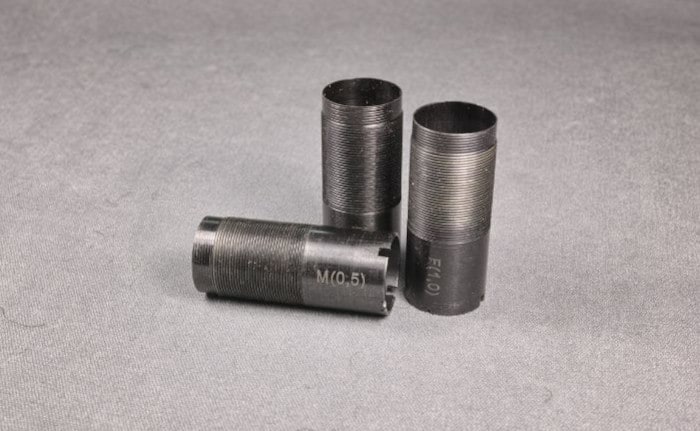
Shotgun Choke Devices
For the most part, shotgun chokes typically fall into one of three categories:
Fixed Choke
A fixed shotgun choke is built into the barrel during the manufacturing process and cannot be changed or adjusted by the shooter or hunter. The only way a fixed choke can be changed would be to have a gunsmith bore the choke out from a constricted choke (say full choke) to a more open choke (say a modified choke).
Fixed choke shotguns tend to be models produced or manufactured after the 1970s and before choke tubes became mainstream around the 1990s.
Adjustable Chokes
Adjustable chokes are devices mounted to the end of the shotgun barrel, allowing the shooter or hunter to change the choke by turning the device. These types of chokes went by many names, including:
- Poly-choke
- Adjuster choke
- Vari-choke
The poly choke design first appeared in the 1920s but wasn’t patented until the early 1930s. As a result, it’s not uncommon to see an adjustable choke mounted on a single barrel shotgun style (pump, semi-auto) that was made between the 1930s and 1960s.
Most poly or adjustable chokes were built with three to four different choke options.
Removable Choke Tubes
The removable choke concept was first commercially available on the Winchester Model 59 semi-auto shotgun in 1959. Over the years, the design of the removable choke tubes has improved to the point where nearly every shotgun on today’s market is equipped with or has the option for choke tubes.
The tubes are easily removed and changed with a special wrench, allowing for quick changes in the field as needed.
In addition, most shotguns equipped with removable choke tubes will accept aftermarket choke tubes or special use tubes. For example, the goose chokes I previously discussed are available in aftermarket versions that screw in as a choke tube.
Choosing the Best Shotgun Choke Tube for Dove Hunting
With all the different choke options on the market today, selecting the ideal or optimal shotgun choke or choke tube for dove hunting can be a tricky and potentially confusing process.
When I’m trying to pick a choke tube for my next dove hunt, I base the decision-making process on three components:
- Dove season specifics
- Shotgun gauge
- Shotgun Load
Let’s look at each component in a bit more detail:
Dove Season Specifics
The specific portion of the dove season plays a role in choosing a choke because doves behave differently as the season progresses.
I generally break the season up into two parts:
- Early Season
- Late Season
Early Season Doves
For many dove hunters, the early portion of the dove season runs from the opening day of the season until the second week of the season.
Most dove hunters hunt hard for the opening day and maybe the following Saturday; then, the hunting pressure begins to die down. By the second week of the season, the number of hunters chasing doves has dropped significantly.
During this hunting period, doves aren’t gun shy yet, so the shooting distances usually average 25 to 35 yards or less, with some hunters being comfortably shooting out to the 35 to 40 yard range.
Late Season Doves
Although the definition of late season varies state by state, most hunters consider the late part of dove season to include the 3rd week of the season until the season ends.
The birds that have survived the first two weeks of the season are different from the birds you hunted on opening day. These birds are now much warier of people and won’t just blindly fly into an area to feed.
Doves that have made it this far in the season are more cautious and more likely to perch near an area overlooking a feeding area, watering area, or grit location and survey for danger. These birds will move on if they detect any potential threat.
Their change in behavior and skittishness usually translates to an increase in flying altitude and more erratic flight patterns. For the hunter, those changes mean more challenging shooting scenarios with longer distance shots.
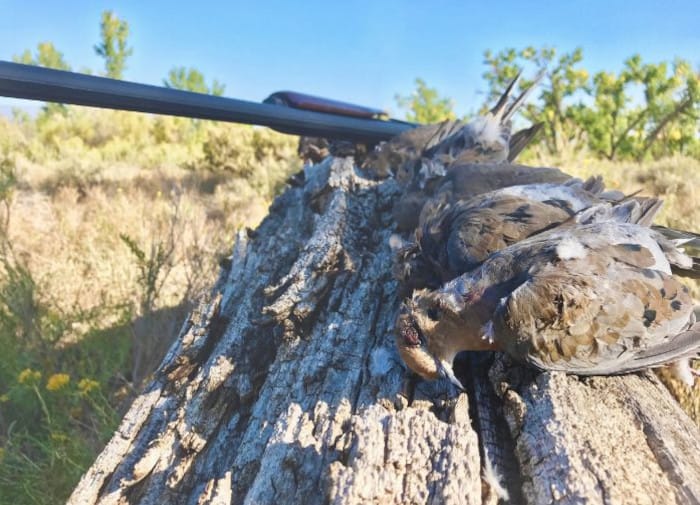
Dove Shotgun Load or Shot Size
Something else to consider concerning your preferred shotgun choke is the specific shotgun load you plan to hunt with. All shotgun shells are listed in a numerical format that identifies the diameter of the pellets and the number of pellets in the shotshell. The higher the shotshell number, the higher the pellet count per shell. The lower the shotshell number, the fewer the number of pellets, but the pellets are larger in diameter.
For example, the average #9 shot 12 gauge shell contains approximately 585 pellets (some brands have more, and some have less), with each of those pellets being about .08 in diameter. On the other hand, the average #6 shot 12 gauge shell contains approximately 225 pellets, but those pellets are .11 in diameter. An easy rule to remember: as the number of pellets per shell decreases, the size of the pellets increases.
Here are the most popular shotshell sizes used for doves:
- 6 Shot
- 7 ½ Shot
- 8 Shot
- 9 Shot
Shotgun Gauge
I also consider the shotgun gauge when picking a choke (assuming the shotgun is not a fixed choke model). The shotgun gauge plays a role in the effective shot distance and the number of pellets being sent at the target.
Here’s a list of the standard shotgun gauges, from the highest and most potent gauge (typically a 12 gauge) down to the least powerful (typically a .410 gauge).
- 12
- 16
- 20
- 28
- 410
Rather than provide an in-depth explanation of each gauge, I’m going to touch on a few significant points, then tie it all together in a discussion of shotgun loads.
- The 12 gauge is the most popular all-around gauge and the most common gauge seen in dove fields.
- The 16 gauge has fallen out of popularity a bit but is still an effective dove hunting gauge.
- Behind the 12 gauge, the 20 gauge is the second most popular gauge and is also commonly used for dove hunting. For recoil adverse hunters who don’t like the 12 ga., the 20 gauge is an excellent option.
- The 28 gauge is more of an upland bird hunting gauge but does see some use for doves. In addition, the 28 gauge’s light recoil and light weight make it a favorite of hunters who want to challenge their wing shooting skills.
- The .410 is the least potent shotgun gauge (although it’s technically a shotgun chambering, but not an actual gauge) and not all that commonly used for doves. It’s popular for beginning shooters and young shooters but has a minimal range.
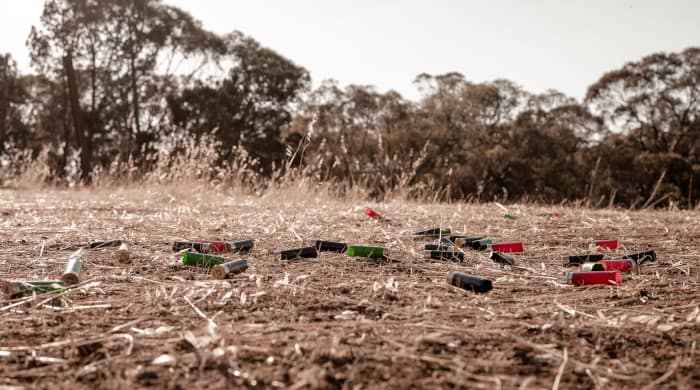
Suggested Choke Options for Dove Hunting
Before I start making choke suggestions, I wanted to mention the following point:
These are merely suggestions based on my experiences. At the end of the day, I’d encourage you to hunt doves with any combination of shotgun gauge, choke, and shotshell you like or enjoy. However, I find that the suggestions below have been the most productive for me.
Let’s combine all this data into some actionable suggestions for shotgun choke based on shotgun gauge:
12 Gauge
For early season dove hunting with a 12 gauge, I’d suggest a cylinder or improved-cylinder choke loaded with number 7 ½ or 8 shot. This choke/shotshell configuration offers a good balance of shot pattern and distance out to the 30 yard to 35 yard mark, which is more than sufficient for most early-season hunts. However, if you happen to be hunting in a scenario where the average shot distance is closer, say 25 yards, and in, you could also use a cylinder choke with number 9 shot. Some #9 shot coming out of a cylinder choke is extremely effective on fast-moving birds at short range.
I’d consider a modified or improved modified choke for the longer shots with number 7 ½ or even number 6 shot for late season dove hunting. If the late season shooting requires even more distance, you could also try a full choke with number 8 shot.
16 Gauge
For early season hunting with a 16 gauge, I’d consider a similar configuration as described with a 12 gauge above.
A quick story about my 16 gauge experience:
As a teenager, I was gifted a Remington 870 Wingmaster in 16 gauge (which I still have), and that was my only shotgun for the longest time. Unfortunately, that shotgun had a fixed full choke, which wasn’t exactly optimal for doves.
However, since it was my only shotgun option at that time, I had to make the best of it. After some trial and error in the dove fields, I found that the full choke loaded with number 9 shot was my best early season option, and I harvested quite a few daily limits with that model. Later in the season, I found that switching from number 9 shot over to number 7 ½ was a better option for the longer shots in a dove field.
20 Gauge
For early season dove hunting with a 20 gauge, I like using an improved cylinder or modified choke with number 7 ½ or number 8 shot. I’m not a fan of using number 9 in a 20 gauge unless the doves are really coming in close. The previously suggested choke and shotshell configuration will offer good pellet coverage and effective bird shooting distance out to 35 yards or so.
For later season hunting, I switch over to an improved modified or full choke since the shooting distances start to stretch out to 40 yards or more. My preferred late-season shotshell is 7 ½ or 6 shot.
I have a Ruger Red Label 20 gauge that’s one of my favorite wing-shooting guns, and I usually configure the choke tubes, so the improved modified barrel fires first and the full choke fires second. If I miss the first shot, the second one will almost always be at a dove rapidly moving away from my location, and the full choke #6 shot gives me a solid chance at making an ethical shot at longer distances. So again, it may not be ideal for your shooting situation, but it works well for me.
28 Gauge
The 28 gauge is in an interesting class by itself because it has a strong following among upland bird hunters. They like the challenge of the smaller gauge coupled with, the lighter weight shotguns typically found in 28 gauge.
For early season doves with a 28 gauge, I prefer a modified or improved modified choke coupled with number 7 ½ or number 8 shells. That combination seems effective out to the 30-yard mark. If you wanted to bump up the effective distance, you could consider going to a full choke configuration with 7 ½ shot. With the 28 gauge, I’d avoid using 9 shot as it just doesn’t seem to have enough pellet power to cleanly harvest doves (at least that’s been my experience).
Personally, I wouldn’t say I like the 28 gauge for the late season because of its limited range. I’ve tried the 28 a few times for later season hunts and ended up wounding more than I killed. Obviously, your own experiences may vary, and you may be a much better wing shooter than I am, but I prefer a minimum of a 20 gauge for late season doves.
410 Gauge
With 410 gauge shotgun for early season, I’d look at either an improved modified or full choke because the effective distance on the gauge is limited. I’d suggest running number 6 or number 7 ½ shot and keeping my shots at doves at distances under 25 yards if possible. I don’t like the .410 for late season dove hunting as I believe there are far better shotgun gauges for that type of hunting.
Without getting on my soapbox about the 410, I wouldn’t suggest it as a dove hunting option unless you were a very experienced wing shooter and strictly wanted the challenge of hunting with such a small gauge.
Most hunters use the .410 as an introductory shotgun platform for young hunters who are recoil sensitive, but my experiences have been that the 28 gauge or 20 gauge with lower powder loads are a better option.
Again, before the hate email starts, I’d like to repeat that these suggestions are based on my hunting and shooting experiences, personally and professionally. At the end of the day, hunt doves with whatever shotgun configuration that brings you the most joy.
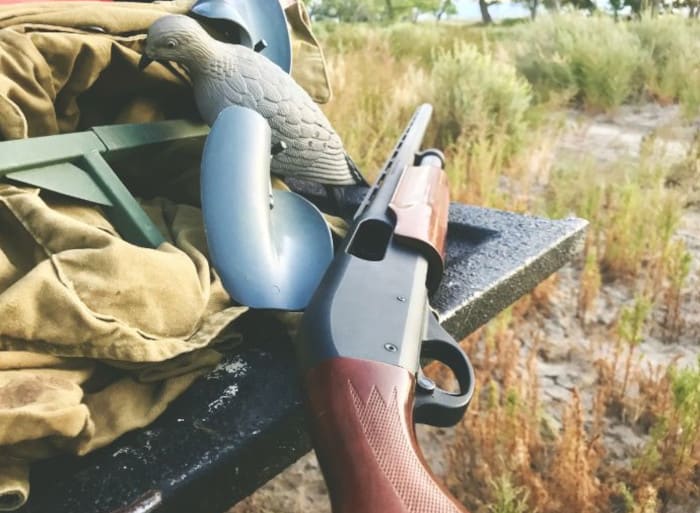
FAQS
Here are some commonly asked questions regarding dove hunting chokes:
Can I use steel shot for dove?
Unless your state has a specific regulation in place prohibiting the use of lead-alternative shot, you can certainly use steel shot for dove hunting. I’ve found that dove hunting with steel shot is just as effective, and steel dove shot costs about the same as comparable lead shot by the same shotshell brand.
Since steel shot tends to be less dense than lead shot, the one suggestion I’d make with steel shot is to move up one pellet size for use on doves. For example, if you usually hunt doves with number 8 lead shot, I’d use #7 ½ or number 6 steel shot.
Using steel shot for doves hasn’t caught on with doves like for waterfowl hunting, but it may become a mandatory dove hunting requirement in the future. For example, some state-managed game lands already have no lead shot rules for all migratory game birds, so you would be required to use steel shot for doves in those locations.
Can I use number 6 shot for doves?
Number 6 shot is a viable shotshell load for doves, especially in situations where the shooting distances are longer than average. While I don’t typically use 6 shot in the early part of dove season, I will use it in the latter portion of the season, especially with a smaller shotgun gauge such as a 20 gauge.
Technically speaking, you can use number 6 shot for doves on opening day, but you’d need to ensure that the bird was farther away than usual, or the breast meat will be destroyed.
What’s the best shot size for dove?
There really is no specific shot size that is ideal for dove hunting under every possible scenario or condition. As previously discussed, the ideal shot size for dove hunting is somewhat tied to factors like the typical shooting distances, shotgun gauge, and shotgun choke.
If I had to pick the best overall and most versatile shot size for dove, I’d go with a number 7 ½ shot since it works effectively for most common dove hunting situations.
Hopefully, the choke and shotshell suggestions made for each shotgun gauge will help you bag more doves with fewer shots.
What is an extended choke?
An extended choke is a type of choke that extends beyond the barrel of the shotgun. It helps in reducing glare and creates a longer and more consistent pattern, making it easier to hit your target.
What is an improved cylinder choke?
An improved cylinder choke is a type of choke that has a larger constriction compared to the cylinder choke. It provides a good balance between tight patterns and wider pellet spread, making it suitable for dove hunting.
Which shot size should I use for dove hunting?
Shot sizes #7.5 or #8 are commonly used for dove hunting. These shot sizes offer a good balance between pellet count and energy, making them ideal for hitting fast-flying doves accurately.
How can I choose the right choke for dove hunting?
To choose the right choke for dove hunting, consider the distance at which you’ll be shooting. If you’re shooting at shorter distances (40 yards or less), a more open choke like improved cylinder or modified choke would be suitable. For longer shots, consider using a tighter choke like a full choke.
Can I use a modified choke for dove hunting?
A modified choke can be an excellent choice for dove hunting. It offers a tighter pattern than an improved cylinder choke, which can be beneficial for longer shots. However, keep in mind that using a tighter choke may require more accuracy as it reduces the pellet spread.
How far should I lead a dove when shooting?
There are several variables that play a role when trying to estimate the amount of lead for dove hunting. Those variables include:
- Distance to the bird
- Speed that the bird is moving
- Type of shotshell being used
- Shotgun choke
As a general rule, I try to aim a few inches in front of the dove’s flight path as my lead distance. As I’m swinging the shotgun on the bird, I try to swing through and past the bird as I pull the trigger.
Can I use non-toxic shot with chokes for dove hunting?
Hunters can use non-toxic shot with chokes for dove hunting. Non-toxic shot is required in certain states and areas as it provides an eco-friendly alternative to traditional lead shot. Non-toxic shot is typically compatible with most choke systems.
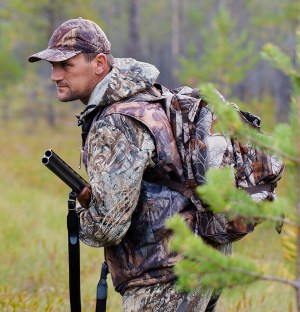
Born and raised in the North Carolina foothills, Andy was introduced to the outdoors at a very young age. Like most beginning hunters, he started out hunting small game like rabbits and squirrels, then graduated to larger species like Whitetail Deer. Although he’s an avid deer and turkey hunter, he still enjoys hunting small game as well. Andy has worked in the hunting and fishing industry for nearly 25 years.

